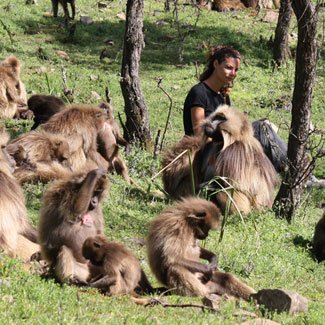Hanging out in the African highlands with gelada baboons

SIMIEN MOUNTAINS, NORTHERN ETHIOPIA: David, a two-year-old gelada baboon, has spent almost his whole life tied up as an illegal pet before being rescued by a woman living in Gondar, a small town in northern Ethiopia. Communications are difficult in the remote highlands, so she makes the nine-hour climb to an altitude of 3000 m into the Simien Mountains National Park to seek out our little group. I’m with my photographer and partner, Nick Pattinson, gelada researcher Aliza le Roux from University of Michigan and her assistant, Vanessa Wilson. We become the recipients of this little monkey parcel.
We have spent the day among hundreds of these charismatic monkeys, watching them play, socialise, fight, eat grass and endlessly chatter to one other. Despite the name, geladas (Theropithecus gelada) are not true baboons, but the last surviving species of the Theropithecus genus of ground-living, Old World monkeys that once ranged throughout Africa and from Europe to Asia. It is estimated that just 50,000 geladas remain of a population that has shrunk by 75% over the past decade. They are found only in the northern Ethiopian highlands, above 2000 m.
With extraordinary manes of luscious hair, a bright red patch of bare skin on their chests and a chimp-like muzzle, the gelada is a highly distinctive and very chatty monkey. It is the most ground-dwelling of primates after humans and, like us, has a fat-cushioned backside for more comfortable sitting.
IT’S THE CHATTERING THAT

AG writer Gaia Vince gets acquainted with the gelada colony
Photo: Nick Pattinson
brought Aliza to the geladas. She’s fascinated by gelada ‘conversations’ and has identified more than 30 different vocalisations. “They are wonderful research subjects,” she tells me, “because unlike other primates, they don’t hide away in the tree tops, and they talk constantly.”
Aliza is a delightfully enthusiastic South African-born scientist, who works tirelessly in this remote, lonely outpost, drawn on by her passion and fascination. She is the first scientist to study the geladas in more than 30 years, because war and civil unrest in the area have made research impossible until now. Aliza has got to know more than 150 individuals, recorded and named them – the glamourously coated males are named after 70s hair bands. By playing back her recordings to specific geladas, she hopes to understand more about the complex social hierarchies within the group.
Just as climate change is impacting the human population here — one-fifth of Ethiopians rely on food handouts to survive after consecutive droughts destroyed crops — the geladas are also affected. The high-protein grasses they eat grow only under certain conditions. Warmer temperatures and erratic rains mean less food, and food of poorer quality. Warm temperatures also allows farmers to grow crops and graze cattle at higher altitudes, to the detriment of the gelada range.
Armed scouts employed by the park, whose job it is to prevent illegal overgrazing, seem to be reducing the numbers of cattle herds in the park, Aliza says. But the grass is still very short and we see plenty of pastoralists with goats, cows and donkeys munching the geladas’ lunch. People here are incredibly poor. Any grazing available for livestock is unlikely to be reserved for a monkey that locals fear and hate.
Aliza and Vanessa, a Scottish graduate volunteering out here for six months, share a small house in the park. The roof and walls were rebuilt for them after the building was bombed in the war with Somalia during the 1990s. It’s here we take David. He mews a little during dinner, but eventually settles down to sleep in Vanessa’s lap in front of the fire.
NEXT MORNING WE’RE ALL up early and David is chattering away. It’s a big day for the little fella: today he’s going to be released, hopefully successfully, into the gelada troop of around 350 individulas that Aliza’s been following. We drive through the park to find them, and they spot David immediately. We’re soon surrounded by hundreds of curious little faces, all struggling to get a look at what the humans have brought.
It’s an anxious moment for all. Vanessa unties the cord that’s been around David’s neck for nearly his whole life, and then steps away from him. Panic stricken, the little monkey jumps on Nick for safety and height, overwhelmed by the many baboons. There follows a series of attempts in which David ventures bravely onto the ground, has an interaction with one or more baboons, and then runs to a human for protection.
After a while, a friendly older male extends a hand and David cautiously allows himself to be groomed. After this, whenever he gets scared, David jumps onto his new friend’s back, who lip-flicks threateningly at the others to keep them back. Above the scene, we all exchange excited glances.
David appears to join the group for a while, playing with other infants and using his new friend and protector for support. At one point he gets scared by a big female and her babies. He loses his friend and panics, clutching at Nick’s ankles. We try to ignore David’s chatterings, hoping he seeks support in the group rather than from one of us.
Aliza and Vanessa end up taking David home again that night, and repeating the process on subsequent days. After some time, the repetitions are successful. David has now settled into the group, made some solid friends and hopefully has a bright future.
Gaia Vince is an Australian journalist who is travelling around the world reporting on the effects of climate change and sending regular dispatches to Australian Geographic. She writes for the BBC, New Scientist and The Guardian. Find her blog at wanderinggaia.com.




